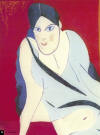|
|
the-south-asian.com January 2008 |
|
|||
|
Health Films
- Book Reviews Heritage
People
|
|
||||
|
By Dinkar Kowshik The British Imperial order in India was a period of learning the art idioms of the ruling masters. There was little scope for imagination or invention. The living streams of art that had enlivened during Mughal and Rajput courts were ignored, as they were not fashionable. The murals of Ajanta, Bagh, or Kochin were forgotten as past phase of little consequence. In such an atmosphere, the spirit of awakening was around the corner. There arrived on the scene such brilliant intellects as Ananda Coomaraswamy, Okakura Kakuzo, E.B. Havell, Abanindranath and others.
The British Imperial order in India was a period of learning the art idioms of the ruling masters. The lingering indigenous art forms continued to express their rural ambience in Kalighat pat, Patna school and in the terracotta temples of Bishnupur and Bankura. These were ignored by the newly educated middle class. The urban outlook was dressed up with imported artefacts and teachers from Britain. Three metropolitan centres got the new art and craft schools manned by British artist administrators. The students were taught the techniques of drawing from life, still life, painting portraits, landscapes where observation and verisimilitude were sole intentions. There was little scope for imagination or invention. Several artists who had financial advantage travelled to England to study further the Victorian art that was popular in the overseas schools. The living streams of art that had enlivened during Mughal and Rajput courts were ignored, as they were not fashionable. The paintings of Malwa, Kangra, Rajasthan or Jain schools or Mughal Kalam from Akbar and Jahangirís royal ateliers were swept aside. The murals of Ajanta, Bagh, or Kochin were forgotten or ignored as past phase of little consequence. Living schools of regional art were replaced by the new imported aesthetics of rulers who carefully directed the young generation of artists, and art connoisseurs to imbibe freshly planted art lessons. In such an atmosphere, the spirit of awakening was around the corner. There arrived on the scene such brilliant intellects as Ananda Coomaraswamy, Okakura Kakuzo, E.B. Havell, Abanindranath and other ....
More in the print magazine. Order your copy now. Annual subscription (inclusive of air shipping & handling) Rs 500 in India £20 elsewhere
|
|||||
|
Copyright © 2000 - 2008 [the-south-asian.com]. Intellectual Property. All rights reserved. |
|||||
